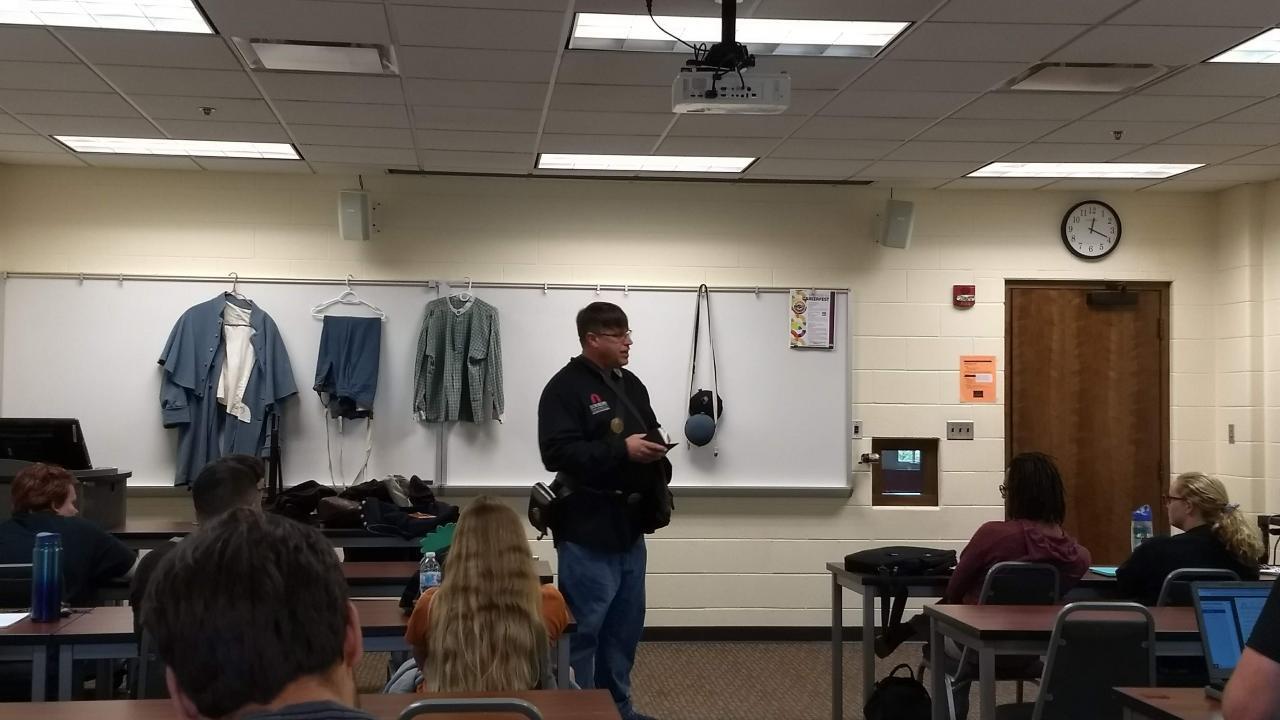Using Footnotes
This page provides instructions for Lourdes University students to use when writing research papers in their history courses.
Historians use the Turabian or Chicago Manual of Style when listing citations (or footnotes) in their works. Kate Turabian was the dissertation secretary at the University of Chicago from 1930 to 1958. The University of Chicago published a lengthy guideline for doctoral students showing them exactly how to set up their work and how to cite sources in footnotes and a bibliography. “Turabian” is the shorter version of the much lengthier “Chicago Manual of Style.”
The source for this style guide comes from the 6th Edition of Kate Turabian’s A Manual for Writers of Term Papers, Theses, and Dissertations (Chicago and London: The University of Chicago Press, 1996).
The Chicago Manual of Style is currently in its 14th edition. See John Grossman’s The Chicago Manual of Style (Chicago and London: The University of Chicago Press, 1993), for a more detailed description of the Chicago style.
PAGE SETUP
- Set the margins at 1 inch all around.
- Use the 12-Point Times New Roman Font.
- Double-space the text.
- Single-space block quotes.
- Indent every paragraph (1/2 inch is a good indentation).
- Add page numbers (1, 2, etc.) at the top center or bottom center of the page.
- Start the page numbering on Page 2 (the cover sheet has no page number).
COVER SHEET
- Type the title in initial caps (only capitalize the 1st letter of each word) centered 1/3 of the way down the page.
- Type the following information centered 2/3 of the way down the page:
- Your Name
- Number and Title of the Course
- Semester and Year of the Course
- Lourdes University
- The Date the Paper is Due
- (Optional: Your Instructor’s Name)
BODY OF THE TEXT
- The body of the text begins at the top of the page immediately after the cover sheet.
- Use ½ inch indents at the start of every paragraph.
- As you type your paper on a computer, make sure you let the text “wrap” at the end of the line.
- Don’t hit “Enter” to create an end of the line character when you’ve reached the end of a line.
- Once again, let the text wrap – this will make it easier for you to go back and edit your text.
- Remember to double space the text and to single space block quotes that are several sentences long.
- Also indent the block quotes (see the page on style guides for footnotes for an example).
PLACEMENT OF FOOTNOTES
The full footnote reference may be placed in one of two places:
- First Method:
- You can place all the footnotes for a page at the bottom of the page of text.
- Use a “separator” (meaning a short line on the left-hand side) to separate the text from the footnotes.
Here’s an example of the first method:
1Benjamin Drake, Life of Tecumseh and His Brother the Prophet (Cincinnati: H. H. Green Press, 1840), 54-76, 80-123, 159-178.
2William Henry Harrison, “History of the Ohio Tribes,” Ohio Archaeological and Historical Quarterly 24 (March 1837): 33-63.
- Second Method:
- You can place all the footnotes for the entire paper in a list. This should go on a page that comes after the text and before the bibliography.
- Type NOTES at the top center of the page and then list the footnotes below.
Here’s an example of the second method:
NOTES
1Benjamin Drake, Life of Tecumseh and His Brother the Prophet (Cincinnati: H. H. Green Press, 1840), 54-76, 80-123, 159-178.
2William Henry Harrison, “History of the Ohio Tribes,” Ohio Archaeological and Historical Quarterly 24 (March 1837): 33-63.
USING FOOTNOTES
A footnote shows your reader the sources upon which you have based your writing.
Generally you will need to place a footnote (meaning a number in superscript at the end of a sentence or a paragraph) in each one of the following three places:
- Usually after the end of a paragraph
- Within and at the end of a paragraph (if two different sources are used)
- After a direct quote that is imbedded in a paragraph
- After a longer block quote
Here’s an example of a footnote after the end of a paragraph:
By the summer of 1863, Joshua Lawrence Chamberlain was the commander of the 20th Maine Regiment. He was given the tough job of holding Little Round Top, a small hill at the far left end of Cemetery Ridge, for the Union. Confederate soldiers from Alabama attacked his position. His men bravely threw back the attack, but were soon out of ammunition.1
Instead of retreating, and giving Little Round Top to the Confederates, Chamberlain decided to do something very brave. He told his men to charge down the hill with their bayonets flashing. The surprised Confederates fell back, and Chamberlain and his men held on to Little Round Top. They took 400 Confederate soldiers as prisoners2
Here’s an example of a footnote within and at the end of a paragraph (if two different sources are used):
The war itself came to Maine as Confederate ships attacked vessels along the coast. Hundreds of sailing ships and fishing boats were captured and destroyed by Confederate raiders.1 Many ship captains sailed to Europe and registered their ships there, hoping the South would not detect them. Others outfitted their boats with guns and cannons, and took their chances along the Atlantic shore.2
Here’s an example of a footnote after a direct quote that is embedded in a paragraph:
The Maine regiments were able to take the cities of Yorktown and Williamsburg. General McClellan praised them by saying, “On the battlefield, you and your comrades arrested the progress, saved the army from a disgraceful defeat and turned the tide of victory in our favor.”2 But despite these two victories, the Union Army failed to take the city of Richmond.
Here’s an example of a footnote after a longer block quote:
A block quote is a lengthy quote that is several sentences long, and should be set off from the rest of the paragraph by being indented and single-spaced.
Joshua Chamberlain described the moment when he saw a Confederate soldier riding toward him carrying a white flag of truce in these words:
Suddenly rose to sight another form, close in our own front, a soldierly young figure, a Confederate staff officer undoubtedly. Now I see the white flag earnestly borne, and its possible purport sweeps before my inner vision like a wraith of morning mist … The messenger comes near, dismounts; with graceful salutation and hardly suppressed emotion delivers his message: ‘Sir, I am from General Gordon. General Lee desires a cessation of hostilities until he can hear from General Grant to the proposed surrender.3
INSERT FOOTNOTES WITH MICROSOFT OFFICE
The insert footnotes using Microsoft Office, position your cursor where you want to insert the footnote. Click on References on the tool bar at the top. Then, click on Insert Footnote. The computer will automatically take you to the bottom of the page to insert your citation.
Things to remember with footnotes:
Footnotes should go at the end of a sentence immediately after the period.
Each footnote receives a unique number. This should happen automatically if you follow the steps above for Microsoft Office.
Right Footnote Style
Here are important guidelines to follow when referencing information in the following sources:
- Books
- Articles in a Scholarly Journal
- Articles in a Magazine
- Articles in a Newspaper
- Single Website
- Article or Primary Source on a Website
- VHS or DVD
- CD-ROM
- Multi-Volume Source
- Encyclopedias or Dictionaries
- Interviews
- Source within Another Source
- Multiple Sources in One Footnote
- Source with an Author and an Editor
Books
For the first time you reference a book in a footnote, list all the information (author, title, city of publication, publishing house, year of 1st publication, and pages) as follows:
1Benjamin Drake, Life of Tecumseh and His Brother the Prophet (Cincinnati: H. H. Green Press, 1840), 54.
For the second and subsequent times you reference the same work in a footnote: List only the last name of the author, the tile of the work (italicized), and the pages. The other publication information does not have to be listed again.
2Drake, Life of Tecumseh, 54.
If the footnote refers to the same work you have used in the footnote immediately preceding the current one, type the word Ibid. and the page number.
3Drake, Life of Tecumseh, 188.
4Ibid., 203.
If you have several paragraphs where you have used the same book but in many different pages, place the footnote at the end of the last paragraph and list all the page numbers in the endnote.
5Benjamin Drake, Life of Tecumseh and His Brother the Prophet (Cincinnati: H. H. Green Press, 1840), 54-76, 80-123, 159-178.
Or
5Drake, Life of Tecumseh, 89-102, 107, 133-167.
6Ibid., 203, 217-247,285-289.
Articles in a Scholarly Journal
For the first time you reference an article in a scholarly journal in a footnote, list all the information (author, article title, journal title, journal volume number, article publication date, and page numbers) as follows:
1William Henry Harrison, “History of the Ohio Tribes,” Ohio Archaeological and Historical Quarterly 24 (March 1837): 33-63. (Note: “24” is the Volume Number, “March 1837” is the date of publication, and “33-63” are the page numbers.)
For the second and subsequent times you reference an article in a scholarly journal: List only the last name of the author, the tile of the work and the pages. The other publication information does not have to be listed again.
2Harrison, “History of the Ohio Tribes,” 54.
If the footnote refers to the same work you have used in the footnote immediately preceding the current one, type the word Ibid. and the page number.
3Harrison, “History of the Ohio Tribes,” 56.
4Ibid., 207.
If you have several paragraphs where you have used the same article but in many different pages, place the footnote at the end of the last paragraph and list all the page numbers in the endnote.
5William Henry Harrison, “History of the Ohio Tribes,” Ohio Archaeological and Historical Quarterly 24 (March 1837): 33-63, 76-85, 112-115.
Or
6Harrison, “History of the Ohio Tribes,” 56, 58-59, 106-112, 115.
7Ibid., 207, 214-116, 222-245..
Articles in a Magazine (Examples: Time or Newsweek)
For the first time you reference an article in a magazine in a footnote, list all the information (author, article title, magazine title, publication date, and pages) as follows:
1Andrew Jackson, “My Side of the Story,” U.S. News & World Report, 5 March 1837, 45-61.
For the second and subsequent times you reference an article in a scholarly journal: List only the last name of the author, the tile of the work and the pages. The other publication information does not have to be listed again.
2Jackson, “My Side of the Story,” 67.
If the footnote refers to the same work you have used in the footnote immediately preceding the current one, type the word Ibid. and the page number.
3Jackson, “My Side of the Story,” 74.
4Ibid., 83-85.
If you have several paragraphs where you have used the same article but in many different pages, place the footnote at the end of the last paragraph and list all the page numbers in the endnote.
5Andrew Jackson, “My Side of the Story,” U.S. News & World Report, 5 March 1837, 45-61, 76-82.
Or
6Jackson, “My Side of the Story,” 56, 58-59, 106-112, 115.
7Ibid., 83-85, 92-101.
Articles in a Newspaper
For the first time you reference an article in a newspaper in a footnote, list all the information (author, article title, newspaper title, publication date, section and page numbers) as follows:
1Alexander Hamilton, “My Battle with Thomas Jefferson,” New York Daily News 12 July 1804, sec. 1A, p. 3.
For the second and subsequent times you reference an article in a newspaper: List only the last name of the author, the tile of the work and the pages. The other publication information does not have to be listed again.
2Hamilton, “My Battle with Jefferson,” 54.
If the footnote refers to the same work you have used in the footnote immediately preceding the current one, type the word Ibid. and the page number.
3Hamilton, “My Battle with Jefferson,” 56.
4Ibid., 207.
If you have several paragraphs where you have used the same article but in many different pages, place the footnote at the end of the last paragraph and list all the page numbers in the endnote.
5Alexander Hamilton, “My Battle with Thomas Jefferson,” New York Daily News 12 July 1804, sec. 1A, pp. 3-5, 14-22, 37.
Or
6Hamilton, “My Battle with Jefferson,” 56, 58-59, 106-112, 115.
7Ibid., 207-214, 222-234.
Single Website
For the first time you reference a single website, give as much information as possible, and include the URL (web address) and the date you last accessed the site:
1Dr. Thomas Brown, The Tippecanoe Battlefield: Recent Developments at the Site, accessed 1 May 2004; available from http://www.tippecanoe.com/recentnews/index.html; Internet.
For the second and subsequent times you reference a website in a footnote, just give the author and the title:
2Brown, The Tippecanoe Battlefield.
3Ibid.
Article or Primary Source on a Website
For the first time you reference an article or primary source posted on a website, give as much information as possible, and include the date you last accessed the site and the URL (web address):
1John L. O’Sullivan, “Manifest Destiny,” Major Documents of the American West, accessed 3 May 2004; available from http://www.amwestdoc.com/destiny/index.html; Internet.
For the second and subsequent times you reference a website in a footnote, just give the author and the title:
2O’Sullivan, “Manifest Destiny”
3Ibid.
VHS or DVD
For the first time you reference a VHS Videocassette or DVD in a footnote, list all the information including the title, the director and producer, the length, the company, and the year (also end with “Videocassette” or “DVD”):
1A Night at the Opera. Produced by Jack Warner. Directed by Michael Curtiz. 115 minutes. MGM. 1935. Videocassette.
For the second and subsequent times you reference a VHS Videocassette or DVD: List only the title.
2A Night at the Opera.
3Ibid.
CD-ROM
For the first time you reference electronic media (like CD-ROMs or online sources such as computer services, networks, and bulletin boards), give the following information:
1Geoffrey Chaucer, The Canterbury Tales. (CD-ROM). (Oxford: Oxford University Press, 1993).
For the second and subsequent times you reference electronic media: List only the author and title.
2Chaucer, The Canterbury Tales.
3Ibid.
Multi-Volume Source
For the first time you list a multi-volume work, make sure you add the volume of the reference:
1Alexis De Tocqueville, Democracy in America, vol. 2 (Oxford: Oxford University Press, 1993), 47-48.
For the second and subsequent times you list a multi-volume work, list the author, title, and volume:
2De Tocqueville, Democracy in America, vol. 2, 49.
3Ibid, 57.
Encyclopedias or Dictionaries
For the first time you reference an encyclopedia or dictionary, make sure you include the following information:
1Avery Symmes, “Captain John Smith,” in Encyclopedia Britannica, 11th ed.
For the second and subsequent times you list an encyclopedia or dictionary, list the following information:
2Symmes, “Captain John Smith,” Encyclopedia Britannica
3Ibid.
Interviews
For the first time you reference an interview that you have taken, give the following information (person interviewed, method of recording, place and date of interview):
1William Jefferson Clinton, interview by author, tape recording, Washington, D.C., 15 August 2004.
For the second or subsequent times you reference an interview that you have taken, just include the following (if there has only been one interview – add the date and location if there were several):
1Clinton interview by author.
2Ibid.
Source within Another Source
For the first time you reference the work imbedded in another work, list the author and the title of the main work you wish to reference (usually a quoted primary source) and then give the information about the book or other source in which it is imbedded exactly as you would if you were citing simply that source.
1Groucho Marx, “Making Movies at MGM in the Thirties,” in Jacob P. Jones, Hollywood’s Greatest Era: The 1930s (Los Angeles: International Press, 1987), 23-24.
For the second and subsequent times you reference a source within a source, list only the author’s last name, title of the actual work you are citing, and the page numbers.
2Marx, “Making Movies at MGM in the Thirties,” 25.
Multiple Sources in One Footnote
If you have multiple sources in one footnote, simply link them together with semi-colons.
1William Henry Harrison, “History of the Ohio Tribes,” Ohio Archaeological and Historical Quarterly 24 (March 1837): 33-63, 76-85, 112-115; Benjamin Drake, Life of Tecumseh and His Brother the Prophet (Cincinnati: H. H. Green Press, 1840), 54-76, 80-123, 159-178.
Source with an Author and an Editor
If you a referencing a work with an author and an editor, you need to get all the following information in the first time you reference the work:
1William Henry Harrison, “Letter to President James Madison, August 11, 1811,” Governor’s Messages and Letters, edited by Logan Esarey (Indianapolis: Bobbs-Merrill and Company, 1956), 54-57.
For the second and subsequent times you reference a work with an author and an editor, list only the author’s last name, title of the actual work you are citing, and the work in which it is imbedded.
2Harrison, “Letter to President James Madison, August 12, 1811,” Governor’s Messages and Letters, 59.
3Ibid, 62-63
Adding the Bibliography
Adding the Bibliography
The final page of your paper lists the works that you used while doing your research.
- At the top of the page, type BIBLIOGRAPHY (centered and all capitals).
- Then list the works you used by the names of the authors in alphabetical order.
- Use a ½ inch hanging indent for each entry (this means the author’s last name directly lines up with the left margin and the second line and later lines in the entry are indented ½ inch).
- List all the information you listed in the footnotes with these exceptions:
- Start each entry with the last name, then the first name of the author.
- Separate pieces of information related to books with a “.” (period).
- Don’t list page numbers for articles.
Here’s an example:
BIBLIOGRAPHY
Drake, Benjamin. Life of Tecumseh and His Brother the Prophet. Cincinnati: H. H. Green Press, 1840.
Hamilton, Alexander, “My Battle with Thomas Jefferson,” New York Daily News 12 July 1804.
Harrison, William Henry, “History of the Ohio Tribes,” Ohio Archaeological and Historical Quarterly 24 (March 1837).
Jackson, Andrew, “My Side of the Story,” U.S. News & World Report, 5 March 1837.
Avoiding Plagiarism
Plagiarism is a fancy word for saying that you have copied someone else’s work and that you have failed to give that person credit for it. Here is how plagiarism is defined in Turabian’s A Manual for Writers:
By definition, a research paper involves the assimilation of prior scholarship and entails the responsibility to give proper acknowledgement whenever one is indebted to another for words or ideas … Failure to give credit is plagiarism.1
1Kate L. Turabian, A Manual for Writers of Term Papers, Theses, and Dissertations (Chicago and London: The University of Chicago Press, 1996), 74.
Here’s some friendly advice for avoiding this mistake: Put everything in your own words.
Remember that when you are writing a history paper, you are using many primary and secondary sources, but in the end, you are telling a story that must come from you and you alone. After you have done all of your research, write the paper from your own viewpoint and in your own words.
Don’t Copy from your Sources Word for Word
No matter how well an author has described something, don’t copy it directly into your own paper, pretending that you have thought these words or ideas up yourself. Take the information and write it from your own viewpoint and in your own words. After you have written the information in your own words, give credit to the person’s work you are basing your own writing on with a footnote.
Note: If you are using a direct or block quote, set it off with quotations or indented text, and add a footnote immediately after the quote.
What if you need to make a direct quote?
You’re writing a paper on Henry David Thoreau and you need a quote from one of his writings to capture his life. Just add the quote directly into the text, making sure that you set it off with quotation marks and also making sure that you add a footnote at the end of the quote. Here’s an example:
In fact, Thoreau was happiest when he was away from the lumber camps. He loved the lakes and called them “amethyst jewels” in the woods.1 He loved climbing mountains and even made it to the top of Ktahdin. He called the mountain a “cloud factory” and was disappointed that he could not see the valley below because of the dense clouds at the summit. “It was like sitting in a chimney,” he wrote, “and waiting for the smoke to blow away.”2
What if you need to make a block quote?
You’re writing a paper on Henry David Thoreau and you need a longer block quote from one of his writings to capture his life. Just add the quote directly into the text, making sure you set it off by indenting it and typing it in single space. Also make sure you add a footnote at the end of the quote. Here’s an example:
Thoreau loved the wilderness of Maine, and over and over again, tried to capture the state’s beauty in words. Here is one of the best examples from The Maine Woods:
What is most striking in the Maine wilderness is the continuousness of the forest … It is a country full of evergreen trees, of mossy silver birches and watery maples … Who shall describe the inexpressible tenderness and immortal life of the grim forest, where Nature, though in mid-winter, is ever in her spring … What a place to live, what a place to die and be buried in! There certainly men would live forever, and laugh at death and the grave!3
Like so many who would follow after him, Thoreau wondered how the beauty of Maine’s wilderness could be preserved, even while the state grew more crowded and more prosperous.
Don’t Cut & Paste from Websites
With easy access to all the information on the Web, some students have found it a simple task to head to a website, find the information they’re looking for, and then simply cut and paste it into their paper. There’s no other way to say this—don’t do this! This is just like sitting down and copying whole sections out of a book. Read the information you find on the Web, and then incorporate the information into your own paper by writing it in your own words. Also give credit to the Website you have used through a footnote. Remember too that it’s the easiest thing in the world for your professor to check your Internet sources.
Don’t Forget to Add Footnotes
It’s a good rule to place a footnote every one or two paragraphs. This allows you to show the reader exactly what works you have used in your own writing. It’s also important to place footnotes immediately after direct or block quotes. Just assume that when you use quotation marks, your reader will be expecting to see a footnote. If you follow the guidelines for setting up your paper, and adding footnotes and a bibliography on this website, you should have no problem providing a faithful record of your research materials and thus avoiding plagiarism.





